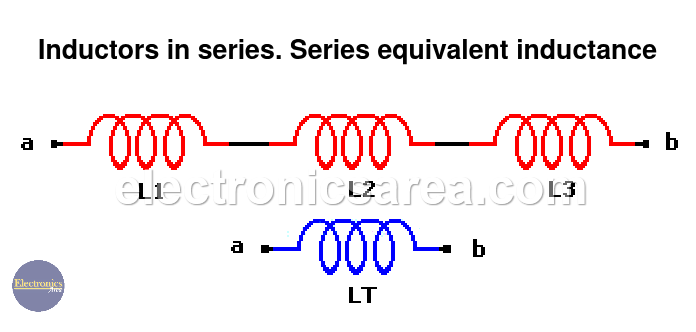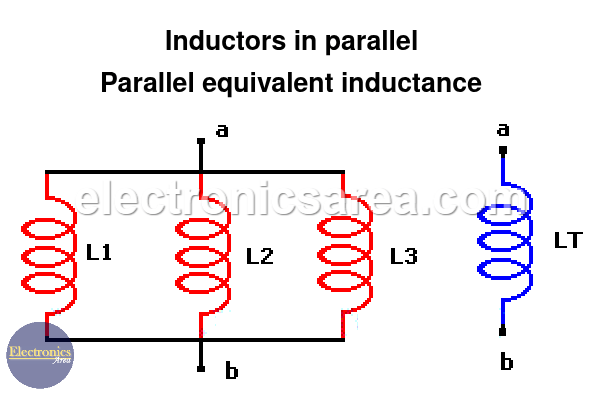Often, it is necessary to find the equivalent value of a set of inductors connected in series or in parallel. These are the simplest methods for calculating the inductance of series and parallel inductors.
Inductors in series. Series equivalent inductance.
The calculation of the equivalent inductor of a set of inductors in series is similar to that of an equivalent resistor of a set of resistors in series; you simply add their values.
The diagram below shows three inductors in series. The formula used here is: LT = L1 + L2 + L3.
This formula works fine for the three inductors in series in the diagram, but for any number of inductors it is better to use the following formula: LT = L1 + L2 + L3 + … + LN, where N is the number of inductors in series.
Example 1:
If we have 3 inductors with the following values:
- L1 = 10 mH
- L2 = 20 mH
- L3 = 30 mH
The equivalent inductor in series is: LT = L1 + L2 + L3 = 10 mH + 20 mH + 30 mH = 60 mH
Example 2:
If we have 4 inductors with the following values:
- L1 = 5 mH
- L2 = 40 mH
- L3 = 20 mH
- L4 = 30 mH
The equivalent inductor is: LT = L1 + L2 + L3 + L4 = 5 mH + 40 mH + 20 mH + + 20 mH = 95 mH
Inductors in parallel. Parallel equivalent inductance
Calculating the equivalent inductance of a set of inductors connected in parallel is similar to calculating the equivalent resistance of a set of resistors connected in parallel.
The diagram above shows 3 inductors in parallel, and the formula used is: 1/LT = 1/L1 + 1/L2 + 1/L3.
This formula works fine for the 3 inductors in parallel of the last diagram, but if we have any number of inductors, we can use the formula: 1/LT = 1/L1 + 1/L2 + 1/L3 + …. 1/LN, where N is the number of inductors connected in parallel.
Example 3:
- L1 = 20 mH
- L2 = 100 mH
- L3 = 50 mH
The equivalent parallel inductor is:
1/LT = 1/L1 + 1/L2 + 1/L3 = 1/20 mH + 1/100 mH + 1/50 mH = 0.05 + 0.01 + 0.02 = 0.08.
1/LT = 0.08, then LT = 1/0.08 = 12.5 mH
Example 4:
- L1 = 100 mH
- L2 = 100 mH
- L3 = 100 mH
- L4 = 100 mH
The equivalent inductor in parallel is:
1 / LT = 1/L1 + 1/L2 + 1/L3 + 1/L4 = 1/100 mH + 1/100 mH + 1/100 mH + 1/100 mH = 0.01 + 0.01 + 0.01 + + 0.01 = 0.04.
1/LT = 0.04, then LT = 1/0.04 = 25 mH






